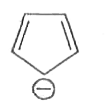Which of the following is aromatic in nature ?



All of these
The correct Answer is:D
To determine which of the given compounds is aromatic in nature, we can follow these steps:
Step 1: Understand Aromaticity
Aromatic compounds are defined by their ability to follow Huckel's rule, which states that a compound is aromatic if it has a planar cyclic structure with a continuous overlap of p-orbitals and contains 4n+2 π (pi) electrons, where n is a non-negative integer (0, 1, 2, ...).
Step 2: Identify the Number of π Electrons
For each compound, we need to count the number of π electrons present in the structure. This includes electrons from double bonds and lone pairs that can participate in delocalization.
Step 3: Check Each Compound
1. First Compound:
- Count π electrons: It has 2 π electrons from the double bond.
- Check if it fits Huckel's rule: n=0 gives 4(0)+2=2. This compound is aromatic.
2. Second Compound:
- Count π electrons: It has 2 π electrons from the double bond and 2 from a lone pair, totaling 4 π electrons.
- Check if it fits Huckel's rule: n=1 gives 4(1)+2=6. This compound is aromatic.
3. Third Compound:
- Count π electrons: It has 2 π electrons from the double bond and 2 from another double bond, totaling 4 π electrons, plus 2 from a lone pair, totaling 6 π electrons.
- Check if it fits Huckel's rule: n=1 gives 4(1)+2=6. This compound is aromatic.
Step 4: Conclusion
Since all the compounds have been shown to have π electron counts that fit Huckel's rule, we conclude that all of them are aromatic in nature.
Final Answer:
All of the given compounds are aromatic in nature.
Aromatic compounds are defined by their ability to follow Huckel's rule, which states that a compound is aromatic if it has a planar cyclic structure with a continuous overlap of p-orbitals and contains 4n+2 π (pi) electrons, where n is a non-negative integer (0, 1, 2, ...).
For each compound, we need to count the number of π electrons present in the structure. This includes electrons from double bonds and lone pairs that can participate in delocalization.
1. First Compound:
- Count π electrons: It has 2 π electrons from the double bond.
- Check if it fits Huckel's rule: n=0 gives 4(0)+2=2. This compound is aromatic.
- Count π electrons: It has 2 π electrons from the double bond and 2 from a lone pair, totaling 4 π electrons.
- Check if it fits Huckel's rule: n=1 gives 4(1)+2=6. This compound is aromatic.
- Count π electrons: It has 2 π electrons from the double bond and 2 from another double bond, totaling 4 π electrons, plus 2 from a lone pair, totaling 6 π electrons.
- Check if it fits Huckel's rule: n=1 gives 4(1)+2=6. This compound is aromatic.
Since all the compounds have been shown to have π electron counts that fit Huckel's rule, we conclude that all of them are aromatic in nature.
All of the given compounds are aromatic in nature.
Topper's Solved these Questions
- HYDROCARBONSBOOK - AAKASH INSTITUTE ENGLISHCHAPTER - HYDROCARBONSEXERCISE - Assignment(Section - A) (Obejctive type question)
26 Videos
- HYDROCARBONSBOOK - AAKASH INSTITUTE ENGLISHCHAPTER - HYDROCARBONSEXERCISE - Assignment(Section - B) (Obejctive type question)
5 Videos
- HYDROCARBONSBOOK - AAKASH INSTITUTE ENGLISHCHAPTER - HYDROCARBONSEXERCISE - Try yourself
78 Videos
- HALOALKANES AND HALOARENES BOOK - AAKASH INSTITUTE ENGLISHCHAPTER - HALOALKANES AND HALOARENES EXERCISE - ASSIGNMENT SECTION -D
15 Videos
- HYDROGENBOOK - AAKASH INSTITUTE ENGLISHCHAPTER - HYDROGENEXERCISE - ASSIGNMENT (SECTION - D) (Assertion-Reason Type question)
15 Videos
Similar Questions
Which of the following is aromatic amine?
View SolutionWhich of the following in not aromatic in nature?
View SolutionWhich of the following is anti-aromatic in nature?
View Solutionwhich of the following is aromatic AA?
View SolutionWhich of the following is acidic in nature ?
View SolutionWhich of the following is amphoteric in nature?
View SolutionWhich of the following is non − aromatic in nature ?
View SolutionWhich of the following is not aromatic?
View SolutionWhich of the following is anti− aromatic in nature ?
View SolutionWhich of the following is aromatic carbanion?
View Solution
